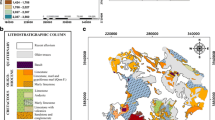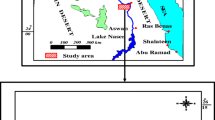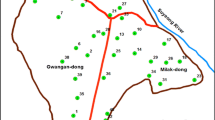Abstract
This study tried to investigate the change in the physical and chemical indices of groundwater in Minab Plain caused by groundwater level decline. In this regard, twelve groundwater samples were drawn from different wells across this plain during 22 November to 22 December 2015. The parameters of acidity, electrical conductivity (EC), and temperature and the major anions and cations were measured in situ and at the regional water laboratory of Hormozgan, respectively. Comparison of the current parameters with EC and chloride Cl−, and the measured parameters during 2006 indicated an increased concentration of EC, Cl−, sodium Na+, bicarbonates HCO3, total dissolved solids TDS, as well as total hardness TH, and a decreased concentration of sulphate SO42− over time. According to the findings in a lower groundwater quality and a higher groundwater salinity, groundwater level and reservoir capacity decreased by 11.3 m and 287.2 million m3, respectively; finally, for quality assessment of the region’s groundwater for agricultural use, values of sodium absorption ratio, sodium percentage (Na%), residual sodium carbonate, and magnesium hazard were computed; comparison of the concentrations of major cations and anions in the regional groundwater showed that the dominant cationic and anionic conditions were Na > Mg > Ca > K and Cl > HCO3 > SO4 > CO3, respectively. Comparison of the measured parameters with Iran’s national standard and the World Health Organization standards showed that the pH and calcium Ca2+ values of all samples were at desirable levels. Results suggested that the regional waters had good, acceptable, and average quality for drinking. In terms of agricultural use, the dominant cations in the regional groundwater were Na+, followed by magnesium Mg2+.







Similar content being viewed by others
References
Ackah M, Agyemang O, Anim AK, Osei J, Bentil NO, Kpattah L, Gyamfi ET, Hanson JEK (2011) Assessment of groundwater quality for drinking and irrigation: the case study of Teiman-Oyarifa Community, Ga East Municipality, Ghana. Proc Int Acad Ecol Environ Sci 1(3–4):186–194
Aghanabati A (2004) The geological map of Minab sheet, scale 1: 250,000. Geological Survey of Iran, Tehran
Carreira PM, Marques JM, Nunes D (2014) Source of groundwater salinity in coastline aquifers based on environmental isotopes (Portugal): natural vs human interference, a review and reinterpretation. Appl Geochem 41:163–175
Datta PS, Deb DL, Tyagi SK (1997) Assessment of groundwater contamination from fertilizers in Delhi area based on 18O, NO3 − and K+ composition. J Contam Hydrol 27:249–262
Demir Y, Sahin S, Guler M, Cemek B, Gunal H, Arslan H (2009) Spatial variability of depth and salinity of groundwater under irrigated ustifluvents in the Middle Black Sea Region of Turkey. Environ Monit Assess 158:279–294
Dindarlou K, Alipour V, Farshidfar GhR (2006) Chemical quality of drinking water in Bandar Abbas. Med J Horm Univ 10(1):57–62
Eaton FM (1950) Significance of carbonate in irrigation water. Soil Sci 69(2):123–133
Ghoraba ShM, Khan AD (2013) Hydrochemistry and groundwater quality assessment in Balochistan province, Pakistan. Int J Res Rev Appl Sci 17(2):185–199
Golchin I, Azhdary Moghaddam M (2016) Hydro-geochemical characteristics and groundwater quality assessment in Iranshahr Plain aquifer, Iran. Environ Earth Sci 75:317. https://doi.org/10.1007/s12665-015-5077-0
Hoek WVD, Konrad SF, Ensink JHJ, Mudasser M, Jensen PK (2001) Irrigation water as source of drinking water is safe use possible. Tropical Med Int Health 6(1):46–54
Iranian National Standards Organization (1992) Physical and chemical properties of drinking water. No. 1053, 4th edn
Khodapanah L, Sulaiman WNA, Khodapanah DN (2004) Groundwater quality assessment for different purposes in Eshtehard district, Tehran, Iran. Eur J Sci Res 36(4):543–553
Krishan G, Singh S, Kumar CP, Garg PK, Suman G, Ghosh NC, Chaudhary A (2016) Assessment of groundwater quality for drinking purpose by using water quality index (WQI) in Muzaffarnagar and Shamli districts, Uttar Pradesh, India. Hydrol Curr Res 7:227. https://doi.org/10.4172/2157-7587.1000227
Kumar M, Singh Y (2010) Interpretation of water quality parameters for villages Sanganer Tehsil, by using multivariate statistical analysis. Water Resour Prot 2:860–863
Lashkaripour GR (2006) The effect of water exploitation on outlet capacity of Bampoor river, vol 1. Final Report of Research Committee, Water Organization of Sistan and Baluchestan Province
Nohegar A (2006) Investigation of physical and chemical properties of water of Minab River. J Earth Sci Res 2(7):1–16
Nohegar A, Hosseinzadeh MM, Habibolahian M (2011) Temporal and spatial analysis of ground waters quality of Minab Plain. Geogr Environ Plan 40(4):45–64
Paliwal KV (1972) Irrigation with saline water. Monogram no. 2, new series. IARI, New Delhi, p 198
Rahnamarad J, Bavali MY, Derakhshani R (2010) Optimization of hydraulic parameters of Iranshahr alluvial aquifer. Am J Environ Sci 6(6):477–483
Rajaei Q, Mehdinejad MH, Hesari Motlagh S (2012) A survey of chemical quality of rural drinking water of Birjand and Qaen plains (in Persian), Iran. J Health Syst Res 7(6):737–745
Ravikumar P, Somashekar RK (2010) Multivariate analysis to evaluate geochemistry of groundwater in Varahi river basin of Udupi in Karnataka (India). Ecoscan 4(2–3):153–162
Richards LA (1954) Diagnosis and improvement of saline and alkali soils. United States Department of Agriculture, Washington
Sadashivaiah C, Ramakrishnaiah CR, Ranganna G (2008) Hydrochemical analysis and evaluation of groundwater quality in Tumkur Taluk, Karnataka State, India. Int J Environ Res Public Health 5(3):158–164
Torkamanitombeki H, Rahnamarad J (2015) The decrease of underground water surface, subsidence and ground drying in Minab Plain: a horrible catastrophe. J Biodivers Environ Sci (JBES) 6(6):534–539
WHO (2004) Guidelines for drinking water quality, recommendations, vol 1, 3rd edn. WHO, Geneva
Wilcox LV (1984) The quality of water for irrigation use. US Department of Agricultural Technical Bulletin 1962, Washington
Acknowledgements
The authors acknowledge and appreciate the provision of water table, chemical characteristics, and physical properties of groundwater data by Hormozgan Regional Water Authority that without which this study would not have been possible.
Author information
Authors and Affiliations
Corresponding author
Rights and permissions
About this article
Cite this article
Torkamanitombeki, H., Rahnamarad, J. & Saadatkhah, N. Groundwater chemical indices changed due to water-level decline, Minab Plain, Iran. Environ Earth Sci 77, 269 (2018). https://doi.org/10.1007/s12665-018-7445-z
Received:
Accepted:
Published:
DOI: https://doi.org/10.1007/s12665-018-7445-z




